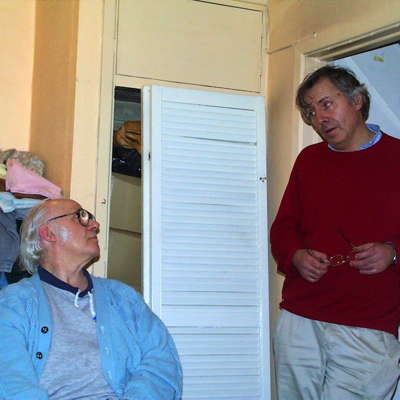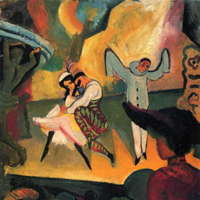 25 YEARS: Classical Music Daily celebrates twenty-five years of daily publication with an hour-long video featuring some of our regular contributors.
25 YEARS: Classical Music Daily celebrates twenty-five years of daily publication with an hour-long video featuring some of our regular contributors.
- Glyndebourne Festival Opera
- paladino media
- Lorenzo Fratini
- Pierre-Augustin Caron de Beaumarchais
- H J Gauntlett
- Christuskirche Stuttgart-Gänsheide
- Leonardo da Vinci Airport
- Jiří Štrunc
 ROMANTICISM: Explore the late George Colerick's fascinating series of articles encroaching on the subjects of melody, romanticism, operetta and humour in music.
ROMANTICISM: Explore the late George Colerick's fascinating series of articles encroaching on the subjects of melody, romanticism, operetta and humour in music.

New Facets of Vital Importance
Little-known music by George Enescu, highly recommended by GERALD FENECH
'Passionate and exciting performances complement an invaluable addition to the Enescu discography.'
George Enescu was born on 19 August 1881 in presently Botoşani County, Romania. He was a child prodigy and the eighth baby of Costache and Maria Enescu, after all previous siblings had died in infancy. It was said that he was given a violin at the age of four and that he progressed rapidly in his studies. Indeed, at the age of five and a half he was already composing short pieces.
In 1888, at the tender age of seven, such was his dexterity that he was accepted as a student at the celebrated Vienna Conservatory, thus becoming the youngest composer ever to study there. It was in this place that he was instructed in violin playing by two renowned composers of the day: Joseph Hellmesberger Jr and Robert Fuchs. While still at the Conservatory, the young Enescu played before Emperor Franz Joseph at the Vienna Court.
The composer became a silver medal graduate when twelve years old, by which time he decided to continue his studies in Paris. In the French capital he took lessons in violin playing, harmony and composition. In the latter category his teacher was none other than Jules Massenet.
In 1897 he produced his first big piece, Poema Romana, which was performed by the Colonne Orchestra, considered one of the finest in the world at that time. In 1901 Enescu wrote the two Romanian Rhapsodies which are, up to this day, his most frequently performed works. The 1936 opera Œdipe was also a big success. The composer also had a prosperous career in the USA as a conductor of the New York Philharmonic and Philadelphia Orchestra, among others. He also conducted the Paris Orchestra for a year. His fame as a teacher was second to none, and among his pupils one finds some legendary names in the form of Yehudi Menuhin, Christian Ferras, Ivry Gitlis, Arthur Grumiaux, Ida Haendel and Joan Field.
Enescu's output is substantial, and he is credited with writing five symphonies (two unfinished), three orchestral suites, three violin sonatas and a number of Piano Quintets and Quartets as well as Cello Sonatas and String Octets. His output also includes several songs and the two works on this recording. Few would doubt Enescu's importance as composer, performer and teacher, and the general consensus is that he was one of the great musicians of the twentieth century. Apart from all this, Enescu is praised for his exceptional memory; it was said that he could reconstruct almost all of Beethoven's works from memory alone.
In the last years of his life Enescu suffered greatly from arthritis, and in 1954 he suffered a stroke that left him paralyzed. Romania's greatest musical son died on 4 May 1955, aged seventy-three.
The Violin Concerto is a highly ambitious work that reflects two different traditions; Viennese Classicism and Late Romantic Virtuosity. Even though Enescu left it unfinished, its total length of six hundred bars is by itself reason enough for admiration and astonishment.
Listen — Enescu: Andante (Violin Concerto)
(track 2, 7:09-8:02) ℗ 2021 Classic Produktion Osnabrück :
The huge first movement is very much moulded on the dimensions of the Beethoven and Brahms concertos, and before the entry of the solo instrument Enescu needs some ninety measures to arrive where he wants.
Listen — Enescu: Allegro moderato (Violin Concerto)
(track 1, 3:07-3:57) ℗ 2021 Classic Produktion Osnabrück :
The Allegro moderato in question employs three themes that are so engagingly formulated that they continue to echo in the ear even after a single hearing.
Listen — Enescu: Allegro moderato (Violin Concerto)
(track 1, 8:55-9:42) ℗ 2021 Classic Produktion Osnabrück :
In June 1898 Enescu composed his Phantasy for Piano and Orchestra, a work combining expressivity à la Brahms with bravura piano technique à la Liszt.
Listen — Enescu: Phantasy for Piano and Orchestra
(track 3, 3:01-4:00) ℗ 2021 Classic Produktion Osnabrück :
The lack of a cadenza for the soloist and the wide-ranging harmony indicate that the work does in fact involve a fantasy and is not the first movement of an unfinished concerto.
Listen — Enescu: Phantasy for Piano and Orchestra
(track 3, 19:22-20:20) ℗ 2021 Classic Produktion Osnabrück :
Both these compositions are still unpublished, but thanks to the enthusiasm of musicologists and Enescu advocates they have never been completely forgotten. Indeed, with the expertise of Pascal Bentoiu and Cornel Taranu, conductor Peter Ruzicka was able to complete the project of recordings of these two Enescu rarities. As a result, our picture of this still unknown composer is enriched by new facets of vital importance. Passionate and exciting performances complement an invaluable addition to the Enescu discography. Highly recommended.
Copyright © 25 January 2022
Gerald Fenech,
Gzira, Malta

CD INFORMATION - GEORGE ENESCU: VIOLIN CONCERTO
CLASSICAL MUSIC ARTICLES ABOUT ROMANIA


